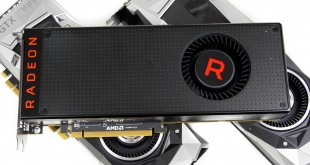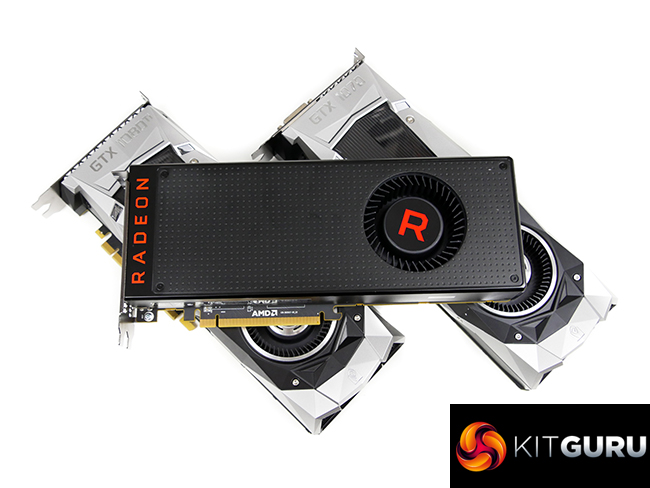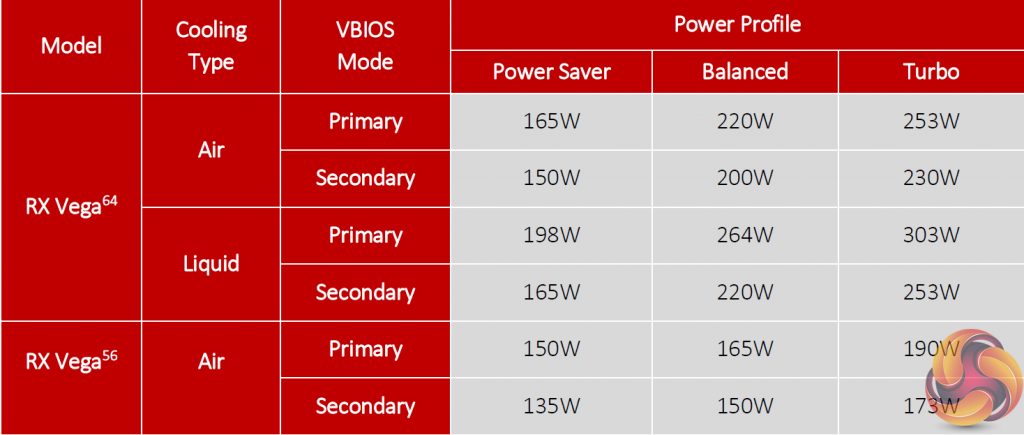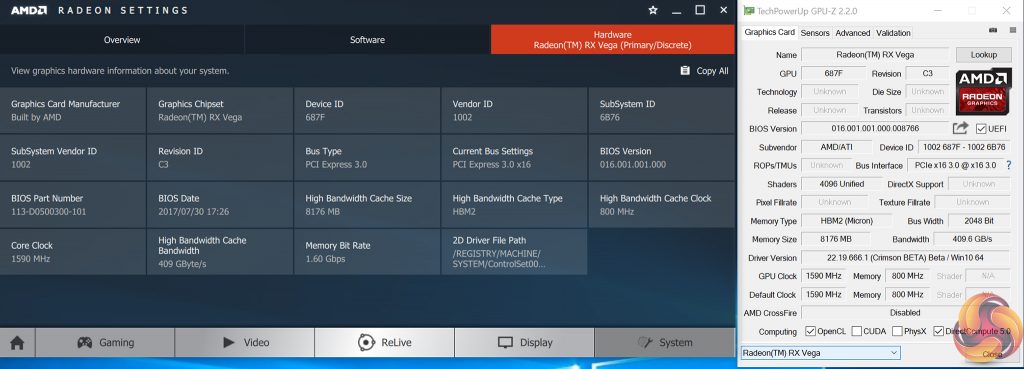
Aiming to strengthen granularity between its market positions that currently pit RX 580 against GTX 1060 in the mid-range and RX Vega64 against GTX 1080 in the high-end, AMD will be releasing the RX Vega56 to compete with Nvidia's highly-popular GTX 1070. Operating as a cut-down version of the Vega 10 GPU, RX Vega56 runs at lower clock speeds than Vega64 and features fewer GPU cores. But in cutting down the GPU and reducing clock speeds, AMD has managed to shave 85W from the rated TDP and has sliced $100 off the MSRP, making RX Vega56 a $399 offering.
Is this the Vega we have all been waiting for?
Before the mining boom drove prices crazy, and prior to Vega's release, the graphics card market was fairly simple. RX 580 competes with GTX 1060 and for anything higher-performance from the current generation crop, you buy Nvidia. However, AMD's launch of the Radeon RX Vega64 has changed that as Team Green now has realistic competition for its high-end GTX 1080 offering. However, the GTX 1070 that has proved such great value to 1440P gamers went largely under the radar against the far more expensive (and higher performance) Vega64 Air option.
That's where Radeon RX Vega56 comes in. AMD is pitting RX Vega56 directly against the GTX 1070 and thinks that the cut-down Vega 10 card with its 8GB of HBM2 memory can prove itself against the cut-down GP104 chip from Nvidia. GTX 1070 is a tough, power-efficient competitor that has ruled supreme in the mid-to-high-end market for more than a year. AMD's tasks is tough but the specs and comparable price points should make for an interesting battle.
| GPU | AMD RX Vega64 Liquid |
AMD RX Vega64 Air |
AMD RX Vega56 | Nvidia GTX 1070 | Nvidia GTX 1080 | Nvidia GTX 1080 Ti |
| GPU Name | Vega 10 | Vega 10 | Vega 10 | GP104 | GP104 | GP102 |
| GPU Cores | 4096 | 4096 | 3584 | 1920 | 2560 | 3584 |
| Base Clock | 1406MHz | 1247MHz | 1156MHz | 1506 MHz | 1607 MHz | 1480 MHz |
| GPU Boost Clock | 1677MHz (Avg) 1750MHz (Max) | 1546MHz (Avg) 1630MHz (Max) | 1471MHz (Avg) 1590MHz (Max) | 1683 MHz | 1733 MHz | 1582 MHz |
| Total Video Memory | 8GB HBM2 | 8GB HBM2 | 8GB HBM2 | 8GB GDDR5 | 8GB GDDR5X | 11GB GDDR5X |
| Texture Units | 256 | 256 | 256 | 120 | 160 | 224 |
| Texture fill rate | 429.3 GT/s | 395.8 GT/s | 330.0 GT/s | 180.7 GT/s | 257.1 GT/s | 331.5 GT/s |
| Memory Bit Rate |
1.89 Gbps effective | 1.89 Gbps effective | 1.60 Gbps effective | 8 Gbps effective | 10 Gbps effective | 11 Gbps effective |
| Memory Bandwidth | 484 GB/s | 484 GB/s | 410 GB/s | 256.3 GB/s | 320 GB/s | 484 GB/s |
| Bus Width | 2048-bit | 2048-bit | 2048-bit | 256-bit | 256-bit | 352-bit |
| ROPs | 64 | 64 | 64 | 64 | 64 | 88 |
| Manufacturing Process | 14nm | 14nm | 14nm | 16nm | 16nm | 16nm |
| TDP | 345 W | 295 W | 210 W | 150 W | 180 W | 250 W |
| Power Connector(s) | 2x 8-pin | 2x 8-pin | 2x 8-pin | 1x 8-pin | 1x 8-pin | 1x 6-pin + 1×8-pin |
| Launch MSRP | $699 (Radeon Aqua Pack) | $499 | $399 | $449 (FE) | $699 (FE) | $699 |
| UK Starting Price (Aug 2017) |
£639 Suggested (Radeon Aqua Pack)
£670+ Current |
£450 Suggested
£550+ Current |
Estimated Approx. £360 | Approx. £350-380 (limited stock) | Approx. £490 | Approx. £670 |
As far as brute force goes, AMD's Vega56 looks to be a more powerful offering than GTX 1070. You get more GPU cores and 8GB of HBM2 memory with significantly higher bandwidth (though note the reduction compared to RX Vega64). However, the lofty core speeds available via the TSMC 16nm process used for Nvidia's GTX 1070 serve to level out the playing field.
We do not yet have confirmed RX Vega56 retail pricing for the UK market as the card is not due to ship until the end of August. However, if the RX Vega64 launch is anything to go by, that MSRP of $399 will be effectively unobtainable in one way or another. In real terms, this should translate into around £360-380. However, the supposedly-£450 RX Vega64 Air quickly shot up by over £100/$100 to £550+/$599+.
We can only analyse the RX Vega56 based on its MSRP of $399 as we have no information suggesting it will be priced differently. Nvidia is not free from criticism in this department, either, as you should consider yourself lucky to get a GTX 1070 at its current MSRP of £329 (there's supposedly a solitary AIB partner SKU coming at that price in a few weeks but we will have to wait and see).
As was the case with RX Vega64, Vega56 features two BIOS modes and software alterations for its power profiles. It is notable how sharp the decrease in power for Vega56 is compared to Vega64. You get a 25% power reduction compared to Vega64 Air in Vega56's ‘Balanced' and ‘Turbo' modes. This speaks volumes for just how far AMD has to push the silicon's clock speed past its optimal efficiency range for Vega64 to hit its performance target.
We suggest that buyers of RX Vega56 cards have a play around with the power profiles to see which ones best fit their performance, noise, and power draw needs. Our testing will be conducted using the ‘Turbo' mode so that we can see the card's all-out performance capability, albeit at the expense of power draw, noise output, and temperature levels.
For more information we encourage you to read our Radeon RX Vega64 Air review HERE, as well as our additional Vega coverage HERE and HERE.
 KitGuru KitGuru.net – Tech News | Hardware News | Hardware Reviews | IOS | Mobile | Gaming | Graphics Cards
KitGuru KitGuru.net – Tech News | Hardware News | Hardware Reviews | IOS | Mobile | Gaming | Graphics Cards






If… this Vega56 could be had not (as now) this blower edition, could be bought in the market without the profiteering inflicted on it… And this is the biggest, if there were 1440p monitors with FreeSync and those weren’t marked-up well beyond the mainstream 1440p. Only then might this have viable appeal.
At this time plunking down the “overage” to move into such upgrade levels of hardware is not a move many should be looking toward. 1440p feels almost past its’ prime or seems bowled-over by a more robust infusion of 4K. So you you’ll be ahead to hold and wait, entry 4K is not that far off with close to a similar cash out-lay of such inflated hardware.
I wish reviewers would stop benching GTA5. It’s ancient and no longer graphically demanding but most importantly, it doesn’t seem to be optimized at all for AMD cards.
As for the power profiles, if the 56 is anything like the 64, the ‘balanced’ mode should only effect performance by 5% but reduce power consumption by 10-30W.
People127s
Office66s
But GTA5 is a really popular game still, and prospective buyers want to see how the card performs on a game they play.
And @LukeHill are you going to reduce the rating of this card after it was revealed that AMD’s introductory price was nowhere near the actual price, thus making the 56 not so much of a great deal for price/performance?
I’m an AMD fan and plan on buying a Vega 56 Monday (Aug 28) if possible. I still play it so it matters to me. I am aware GTAV does significantly worse on AMD though, which is exactly why it won’t deter me from purchasing Vega.